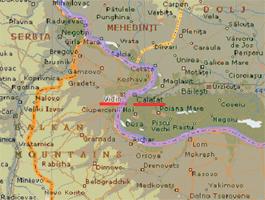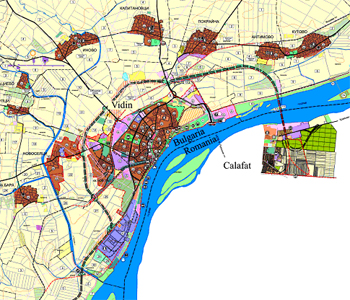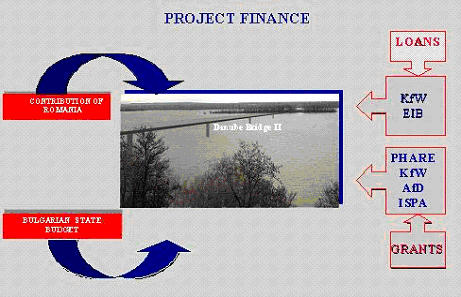 |
 |
 |
 |
 |
 |
 |
 |
 |
 |
 |
 |
Project description
Name der Fallstudie
Project for a New Bridge over The Danube (Vidin -Calafat)
Projekt Neue Brücke über die Donau (Vidin- Calafat)
Description of context
National Strategy for the transport infrastructure development in the period 2000- 2006.
Three main priorities are outlined in the transport sector in Bulgaria:
? Harmonization of national legislation and transport regulations with those of the European Union Member States;
? Development of the transport infrastructure;
? Implementation of the Structural Reform and privatization in the transport sector.
According to the Strategy the potential negative environmental effects of the sector development should be foreseen and minimized. Formulating broadly acceptable environmental solutions in connection with traffic growth and undesirable modal split by providing sustainable infrastructure construction are some of the challenges to be met. The key objectives in solving the environmental problems caused by the transport sector and concerning the urban development comprise:
? Improving the environmental performance of transport infrastructure plans and projects ? all transport infrastructure projects should have an EIA report, the principles of which have to be applied to all levels of decision-making with the respect to development of the transport infrastructure network;
? Limiting the increase of transit inter-urban car traffic;
? Improving urban bus transport with respect to environmental aspects;
? Promoting the use of rail transport;
? Promoting the use of combined transport, etc.
In accordance with the National Strategy a Programme for Transport Infrastructure Development for the period 2001- 2005 (PTID) was elaborated in 2000, incorporating projects of multi-national importance situated along the Pan-European Corridors. The priority infrastructure projects were determined according to adopted selection criteria:
? state of transport infrastructure at the beginning of 2001;
? forecast for the overall national economic development for the period;
? forecast for the increase in traffic flow as a result of the general economic growth and the country?s new political and economic links within the region and in Europe;
? compliance with national and European priorities in creating a Pan-European transport network.
The main goals of the PTID comprise:
? Development of the country?s transport infrastructure as an integral part of the Trans-European Network (European transport corridors N 4, 7, 8, 9 and 10, crossing Bulgaria);
? Reconstruction and modernisation of the existing transport infrastructure in compliance with EC standards and requirements;
? Development of environment friendly transport systems and technologies for freight and passenger transportation, decreasing the negative impact of transport on the environment and human health;
? Development of rail infrastructure, modernization and electrification of railway transport;
? Increasing the safety of all modes of transport;
? Promoting and accelerating the development of combined transport;
? Introducing telecommunication and informational technologies into all modes of transport.
Priority goals for the development of the national transport infrastructure are the achievement of high-quality local services and the integration with the European transport infrastructure. The development of the national transport infrastructure is expected to contribute for generating conditions to attract transit traffic along the Eurasian transport corridors and to provide rapid and comfortable railways and roads. This goal is to be achieved by strategic projects based on trans-border cooperation.
Description of project - background
One of the Main Investment Projects (included in PTID) for Infrastructure Development along Pan-European Transport Corridor 4 includes the construction of a second Danube bridge between Bulgaria and Romania to cross the river at kilometre 796 in the vicinity of two towns: Vidin in Bulgaria and Calafat in Romania (below). The bridge construction was considered essential for the overall improvement and development of Transport Corridor 4 and will affect other major projects in Bulgaria.
The proposed bridge was to be a road/rail one with possibly a dual 2-lane carriageway standard and a single electrified railway line (technical parameters still to be determined). Links to the existing road and railway infrastructure were also planned. The location at the Vidin-Calafat bridge brings benefits to the local population, too.

Locality of Vidin town
Vidin is situated 199 km north-west of Sofia, on the right bank of the Danube. At present it is linked to Calafat by a ferry.
The initiative for the project elaboration was undertaken by Bulgarian Government through proposing 10 relevant places (recommended by ERM Lahmaeyer International) for the bridge location. Romanian Government accepted the territory near the towns of Vidin and Calafat as most suitable.
Actors in the project development: Bulgarian and Romanian governments, strategic donors, financial supporters (Kreditanstalt fur Wiederaufbau (KfW), European Investment Bank (EIB), Phare, Agence Francaise de development (AfD), ISPA), Municipalities of Vidin and Calafat, planning and design companies, local private business.
Description of project - objectives/aims
The construction of a second combined road and rail bridge over the Danube is one of the priority projects included in the Stability Pact for international assistance. The project objective is to provide a second fixed Danube crossing between Bulgaria and Romania, which are at present connected by a single road/rail bridge at Ruse-Giurgiu, some 300 km downstream.
Description of project - time interval and stages
The project life cycle follows five main stages:
? Preliminary studies;
? Project and design management;
? Bridge construction;
? Construction of the adjacent infrastructure;
? Bridge operation.
The first stage comprised a Preliminary Study on the Environmental Impact Assessment, Preliminary study on Economic, Financial and Technical analyses and Updating of the Territory Settlement Plans (TSP) of Vidin (approved in 2002) and Calafat in the area of the New Bridge. (see below)
Currently (2004), a procedure for elaboration of a final bridge design project is going on, which is based on the conclusions and recommendations of the preliminary studies.

Final Vidin Territory Settlement Plan
Description of project - financing
An agreement regulating technical, financial, legal and organisational issues was signed between Bulgarian and Romanian Governments in June 2000. Subsequently Bulgarian Government provided the financing of both the preliminary studies and the partially for construction through five agencies ?EIB, Phare, ISPA, AFD, KfW and national Bulgarian budget (see below).

Project finance scheme
Description of project - other sectors involved
A waste management problem was identified by the preliminary studies (EIA and Economic, Financial and Technical analyses.). Thousands of tones of construction waste were foreseen during the bridge construction while the adjacent sites were estimated not to relevant capacity for land filling. It was recommended to build proper landfills before the bridge construction starts.
Welche Tools wurden verwendet, um Nachhaltigkeit zu beurteilen?
Weiterführende Informationen (nur auf Englisch):